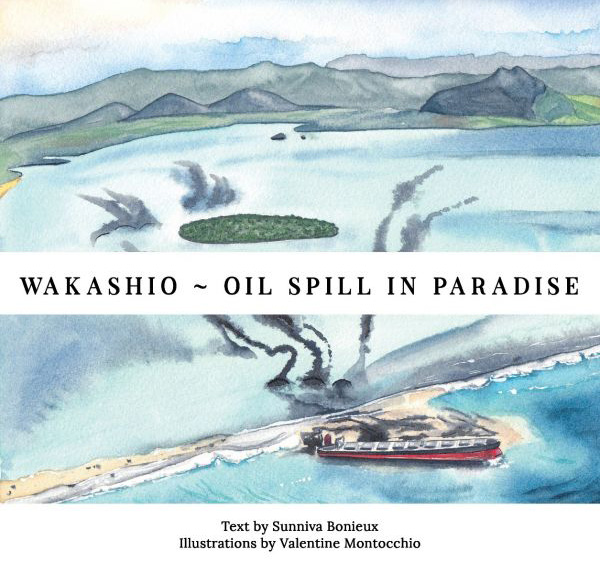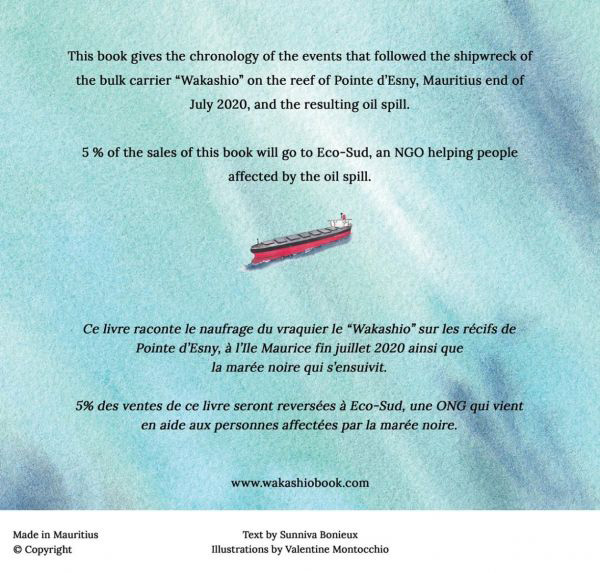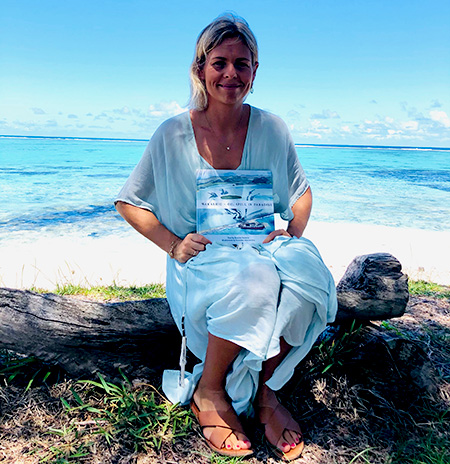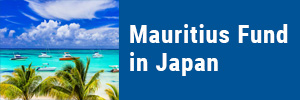Picture Book about Oil Spill Published in Mauritius
Last November, a picture book called WAKASHIO -OIL SPILL IN PARADISE - was published in Mauritius. The books are on display in hotels and schools, and some of the sales proceeds will be donated to support people affected by the incident, through a local NGO.
The book is written in two languages, English and French, and with easy-to-understand sentences and pictures, the feelings and questions of the residents directly impresses the readers. It also chronologically explains how the accident happened and how it affected local residents.


Cover/Back cover of WAKASHIO -OIL SPILL IN PARADISE -
MOL purchased 100 copies of the book and will distribute and display them within the group, with two objectives-helping us understand the local perception of this incident and sharing awareness so that we never again allow such an incident to occur.
We interviewed the book's author, Sunniva Bonieux, and asked her to talk about the story behind the book, what she thought about the incident after witnessing it, and how she felt about the effects afterwards.
- - Who am I?
-

Sunniva Bonieux
(Interviewee: Author of WAKASHIO -OIL SPILL IN PARADISE -)I am Sunniva. I am from Norway, but I have been living in Mauritius for almost nine years.
I am married to a Mauritian and we have two little boys.
We live in Pointe d’Esny, which is the village next to where the WAKASHIO ran aground.
We use the beach and lagoon as our backyard on a daily basis and have been seeing the WAKASHIO every day since the incident.The evening of the incident our friends told us there was a boat on the reef and my husband took our boat out to see what was happening up close.
He was volunteering, helping to put out booms(*) from the first day of the oil spill. Through his work and long days at sea, I got most of the information that I used to write the book.(*) A control material for preventing the spread of oil spills. Also known as oil fence.
- - And is this your first book?
- Yes, the book is a completely new direction for me.
- - Why was it important for you to put this story on paper and to focus on the younger generation?
- I thought it would be a good idea to keep a chronology of the various events that followed the grounding.
I think that kids have a lot of questions and it is nice to be able to explain to them what happened and why it happened, and a book with illustrations is the best way to do so. - - How would you describe what you felt when you learnt about the shipwreck?
- I was shocked and very sad.
First, knowing that this massive ship was crushing our beautiful and healthy reef.
Then when we learned that the ship was carrying 4,000 tons of bunker fuel oil, I was extremely worried about what a leak could do to the area.
Days were passing, and from what I could see not much was done to remove the oil from the ship.
I was worried a leak would happen, and when it happened it felt like a nightmare that had become a reality. - - Tell us more about your book, what does it contain?
- As I briefly mentioned it tells the factual chronology of events that followed the grounding of WAKASHIO.
I have an illustration on each page that relates to the text next to it.
The illustrations are aquarelles by a local artist and a friend of mine, Valentine Montocchio.
The text is in both English and French. - - How did you get the idea of writing a book?
Living in Pointe d'Esny, we were right in the middle of the whole WAKSHIO saga.
We followed the evolution of the salvage operation as we are directly impacted, like everyone that lives around here.With so much attention on the WAKASHIO and the series of unfortunate events that have happened since the wreck.
I thought to myself: surely people will want to have a book that summarizes all this.
It is not every day that a 300-meter ship crashes on our reef and starts an oil spill!- - What is the core message behind it?
- The message we want to pass on in the book is the amazing unity that the Mauritian population showed right after the oil spill.
But also, the feeling of helplessness and frustration as we followed the events with very little explanation from our government officials.
The Mauritian population was deeply moved by this catastrophe and we do not intend to forget what happened and how it happened.
I hope that through this book, the readers will have a better understanding of the whole chronology of events. - - What are your impressions of the Mauritians who decided to help?
- It was amazing to see how everyone got together to help.
People would not hesitate to jump into the oil if needed and everyone was coordinating very well together to make things happen. - - According to you, what should be done in the future to prevent this kind of disaster from hitting us again?
- In the first place, that boat should never have landed where it did.
It should have been picked up by our radar.
So I think the priority is to have a better qualified/trained coast guard that can recognize a threat coming our way, and act to prevent it. - - What have you heard about MOL, the charterer of the bulk carrier?
- I confess that I am not very familiar with shipping companies such as MOL. Prior to the WAKASHIO grounding, I had never heard of them. I got to meet Mr. Goro Yamashita at a community market in Pointe Jerome.
I was selling my book there and Mr. Yamashita approached me and introduced himself and his company MOL.
The incident had a serious impact on the beautiful evironment of Mauritius and the people who live there.
Through the MOL Group's teamwork and effort, we are working to build awarness of this incident among employees throughout the entire group, show emphathy with the feelings of those affected by the incident, and push forward with the restoration of the natural environment and mid-to-long-term social contribution activities.


